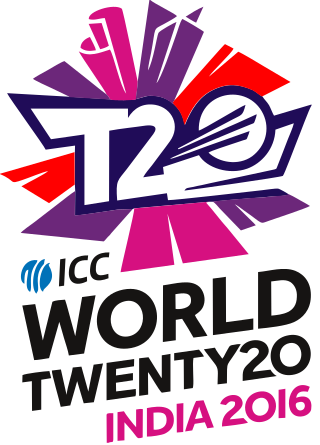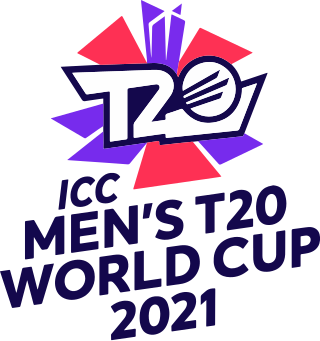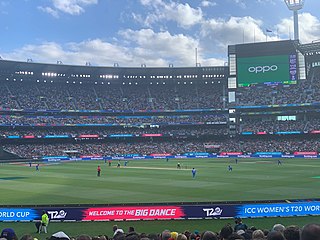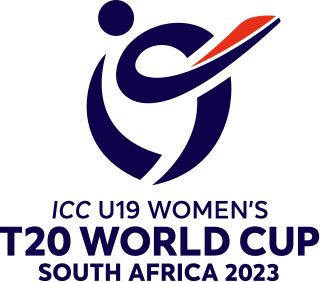
The England women's cricket team represents England and Wales in international women's cricket. Since 1998, they have been governed by the England and Wales Cricket Board (ECB), having been previously governed by the Women's Cricket Association. England is a Full Member of the International Cricket Council, with Test, One Day International (ODI) and Twenty20 International (T20I) status. They are currently captained by Heather Knight and coached by Jon Lewis.
The International XI women's cricket team was a team that took part in two Women's Cricket World Cups. They were essentially a "best of the rest" team, including players not selected by their own countries. They took part in the 1973 Women's Cricket World Cup, finishing in fourth place, and returned for the 1982 tournament, finishing in last place. Their overall record in ODIs was played 18, won 3, lost 14, with one no result.

The 1993 Women's Cricket World Cup was an international cricket tournament played in England from 20 July to 1 August 1993. Hosted by England for the second time, it was the fifth edition of the Women's Cricket World Cup, and came over four years after the preceding 1988 World Cup in Australia.
The 1997 Women's Cricket World Cup, also known as the Hero Honda Women's World Cup, was the sixth edition of the Women's Cricket World Cup, held in India. With 32 matches involving a record 11 teams across 25 cricket grounds, England, Australia, New Zealand and India reached the semi-finals, with Australia and New Zealand progressing to the final match, which was played on 29 December 1997. Australia defeated New Zealand by five wickets to win their fourth championship title.

The 1988 Shell Bicentennial Women's World Cup was an international cricket tournament played in Australia from 29 November to 18 December 1988. Hosted by Australia for the first time, as part of the Bicentenary celebrations, it was the fourth edition of the Women's Cricket World Cup, and came six years after the preceding 1982 World Cup in New Zealand.
The 1978 Women's Cricket World Cup was an international cricket tournament played in India from 1 to 13 January 1978. Hosted by India for the first time, it was the second edition of the Women's Cricket World Cup, after the inaugural 1973 World Cup in England.

The 2016 ICC World Twenty20 was the sixth edition of the ICC Men's T20 World Cup, formerly known as the ICC World Twenty20, a Twenty20 International cricket tournament that was held in India from 8 March to 3 April 2016, and was the first edition to be hosted by India.

The 2021 ICC Men's T20 World Cup was the seventh edition of the ICC Men's T20 World Cup, formerly known as the ICC World Twenty20, a Twenty20 cricket tournament that took place from 17 October to 14 November 2021. The tournament was hosted by United Arab Emirates and Oman. It was scheduled to be hosted by Australia in 2020 but later postponed to 2021 due to the COVID-19 Pandemic.

The 2022 ICC Women's Cricket World Cup was the twelfth edition of the Women's Cricket World Cup, which was held in New Zealand in March and April 2022. It was originally scheduled for 6 February to 7 March 2021 but was postponed by one year due to the COVID-19 pandemic. On 15 December 2021, the International Cricket Council (ICC) announced that the tournament would start on 4 March 2022, with the final scheduled for 3 April 2022.
Ingrid van der Elst is a Dutch former sportswoman who represented her country in both cricket and field hockey. In hockey, she was a goalkeeper for the Dutch national indoor team, while in cricket she played as a right-handed batter, right-arm off break bowler and occasional wicket-keeper, and represented both the Netherlands and International XI, playing seven One Day Internationals for the latter team at the 1982 Women's Cricket World Cup. She played domestic cricket for Wellington.
Babette van Teunenbroek is a Dutch former cricketer who played as a right-handed batter. She appeared in nine One Day Internationals for the Netherlands between 1984 and 1989, and one One Day Internationals for International XI at the 1982 World Cup. She played club cricket for the Amsterdamsche Cricket Club (ACC) and the Haarlemsche Cricket Club Rood en Wit (R&W).

The 2018 Women's World Twenty20 was the sixth edition of the ICC Women's World Twenty20, hosted in the West Indies from 9 to 24 November 2018. It the second World Twenty20 hosted by the West Indies, and the West Indies were the defending champions.

The 2018 ICC Under-19 Cricket World Cup was an international limited-overs cricket tournament held in New Zealand from 13 January till 3 February 2018. It was the twelfth edition of the Under-19 Cricket World Cup, and the third to be held in New Zealand after the 2002 and the 2010 events. New Zealand became the first country to host the event thrice. The opening ceremony took place on 7 January 2018. The West Indies were the defending champions. However, they failed to defend their title, after losing their first two group fixtures.

The 2020 ICC Under-19 Cricket World Cup was an international limited-overs cricket tournament that was held in South Africa from 17 January to 9 February 2020. It was the thirteenth edition of the Under-19 Cricket World Cup, and the second to be held in South Africa after the 1998 event. Sixteen teams took part in the tournament, split into four groups of four. The top two teams from each group advanced to the Super League, with the bottom two teams in each group progressing to the Plate League. India were the defending champions.

The 2020 Women's T20 World Cup was the seventh Women's T20 World Cup tournament. It was held in Australia between 21 February and 8 March 2020. The final took place at the Melbourne Cricket Ground on International Women's Day. Hosts Australia won the tournament, beating India by 85 runs, to win their fifth title.

The 2023 Women's T20 World Cup was the eighth edition of Women's T20 World Cup tournament. It was held in South Africa between 10 February and 26 February 2023. The final took place at Cape Town. Australia won their sixth and third consecutive title after beating the hosts South Africa in the final by 19 runs.

The 2020 ICC Women's T20 World Cup Final was a day/night Women's Twenty20 International cricket match played on 8 March 2020 between Australia and India at the Melbourne Cricket Ground in Melbourne. It was the culmination of the 2020 ICC Women's T20 World Cup, the seventh of the tournament history since it started in 2009. Australia won the match by 85 runs, securing their fifth T20 World Cup title. This was the first time that India had reached the final.
The 2020 Australia women's Tri-Nation Series was a cricket tournament that took place in Australia in January and February 2020. It was a tri-nation series between Australia women, England women and the India women cricket teams, with the matches played as Women's Twenty20 International (WT20I) fixtures. All three teams used the series as their final warm-up ahead of the 2020 ICC Women's T20 World Cup.

The 2023 ICC Under-19 Women's T20 World Cup was the first edition of the Under-19 Women's T20 World Cup, hosted by South Africa in 2023. The tournament was moved from its original slot at the end of 2021 to January 2023 because of the COVID-19 pandemic. Sixteen teams competed in the tournament, initially divided into four groups.

The 1982 Women's Cricket World Cup Final was a one-day cricket match between the Australia women's national cricket team and the England women's cricket team played on 7 February 1982 at Lancaster Park in Christchurch, New Zealand. It marked the culmination of the 1982 Women's Cricket World Cup, the third edition of the tournament, but was the first time a final had been held; both the previous events had been round-robin tournaments. Both Australia and England had previously won the competition; England won the inaugural tournament in 1973, while Australia won in 1978. Australia won the match by three wickets to claim their second world title.















